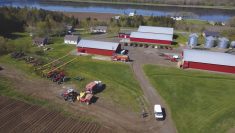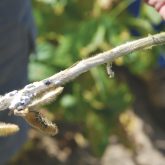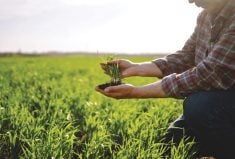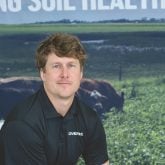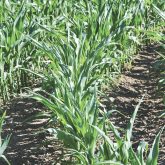The Loewiths don’t describe themselves as a crop innovators, but they’re certainly not hesitant to glean advice from others and, with some careful consideration, adapt a practice or an approach to the conditions on their farm. So, while the move to no till in a dairy operation might seem a little different to some, with one year in the field, the family is comfortable with the decision and looking forward to what the 2016 growing season will bring.
The current Loewiths are the latest in this family of dairy farmers who have been in operation since 1947, south of Copetown, Ont., just west of Hamilton. Carl stepped into the family business in 1970, was joined by his brother Dave in 1975 and then Carl’s son Ben as an equal partner in 1998. They’re now milking 400 head, three times daily, and have 850 head in total on the farm. In addition to Carl, Dave and Ben, there are two other full-time employees — Mark Wynands and Laura Schuurman —and 10 to 12 part-time workers.
Read Also

Agronomists share tips for evaluating new crop products and tech: Pt. 3
With new products, new production practices and new technology converging on the agriculture industry at a frenetic pace in recent…
No tilling definitely sets the Loewith operation apart from other dairy producers — there aren’t that many in the sector that no till, although those numbers are on the rise. But what also differentiates the Loewiths’ operation is their move to have more of their field work performed by custom operators, another trend that’s increasing, even if it’s at a slower pace.
“More and more, we’re doing less and less field work ourselves — we hire all of that to be done — to the point where we’re just about 100 per cent other people doing that custom work,” says Carl. “We probably have less farm machinery on the farm today than any time in the past.”
The 2015 growing season was their first for no till, and Carl concedes that it was an easy year to start the practice. An open and relatively warm spring made it simple to switch, and the planting on the 800 acres that he and his family own and rent was complete in about nine days. If it had been a cold, wet spring, Carl is certain he’d be assessing no till with a different perspective, in spite of the cost and time savings.
“The workload for us was significantly less, the window of planting was shortened-up, which was a nice bonus, and again, it was good year for that sort of thing,” says Carl. “And the yields were acceptable. In the early part of the growing season, maybe it wasn’t as nice looking, but when the corn gets two feet tall, there’s really no difference.”
Positive trend
The move to no till, even in a dairy operation, is something that Allan Spicer believes is certainly worth considering, and the fact that the Loewiths are trying to make it work speaks very well of the practice. Spicer, who works with Can Grow Crop Solutions and also as an adviser for dairy and row-crop producers, knows of a handful of other dairy farmers who are long-term no-tillers, some for 20 years or more. The primary challenge for dairy producers is managing the manure, and no till is seen as an impediment to getting that job done.
But Spicer mentions studies from Agriculture and Agri-Food Canada (AAFC), and another from the U.S. that indicate applying manure on a cover crop does more to hold nutrients and reduce the chances of runoff, either from bare ground or through incorporation.

“What’s unique about the Loewith family is that they’re considered one of the best dairy operations in Canada,” says Spicer, adding that they’ve been in the top three Dairy Herd Improvement (DHI) award winners in the past 15 years. “For them to go no till, they’re not known as innovators in crops, so they’ll turn some heads, because they’re known for dairy in the barn, and this will see them innovating in the field.”
Again, cost and time savings are the major motivators behind the switch to no till, and the cost savings are especially important, given any future impacts of the Trans-Pacific Partnership (TPP) and the Comprehensive Economic and Trade Agreement (CETA). Fold in any concerns about commodity prices and the impact on feed, fertilizer and fuel, and the need to manage costs has the potential to be all the more critical for the dairy sector.
“They challenged me to find someplace in their operation where they can cut some costs, because the price of milk they get at the farm gate is likely to go down for the next 10 years instead of up,” says Spicer.
It’s not that the idea of no tilling in dairy is a trend that’s being imported from Europe or the U.S., either, it’s just a matter of adding up costs and losses in revenue and finding a better of way of doing things, Spicer says. “I mentioned that no till was the way to go and that we could preserve the key nutrients that we’re putting on.”
Main considerations
The decision to go with no till as a management system was actually preceded by planting an oat cover crop, to capture available nitrogen from the manure. Spicer adds that the “living cover crop” approach is ideal, and that oats was the choice of cover over rye because the oats die off easier than rye, which can become harder to deal with on a volunteer basis.
But in Spicer’s experience, the key to making no till work is having the right equipment and the right people running that equipment (in a custom operator scenario). The custom operator that the Loewiths trust is Randy Garland, who Spicer maintains is interested more in quality than quantity. The planter configuration Garland uses has what some might call an “aggressive” coulter setup, mostly to deal with corn stubble left behind by silage harvest in the fall. In the past, he’s grown some soybeans and a few acres of corn for grain harvest, both of which are expected to decrease in the years ahead.
It’s Garland’s understanding of how his equipment works, and the role it’s playing in this changing no-till environment that impresses both the Loewiths and Spicer. Garland works his customers’ land as though it were his own, a point which was demonstrated at one point last year when conditions were simply too wet following a rainy day. Instead of forcing the issue, Garland simply returned to the field a few days later when conditions had improved.
“The nice thing is that because you don’t have to do the tillage, that simplifies a wet spring, too,” says Spicer, highlighting the misconception that no till won’t work in certain conditions. “It’s a challenge in a backward spring, but that kind of spring is a challenge for everybody,” he says. “No till takes a little more management and a little more patience. But there’s no reason why it won’t work, and you know that going in.”
That misconception is particularly daunting, yet interesting to Spicer. Farmers may think they can’t no till their operations because it’s too cold, yet he maintains there’s really only about a degree temperature difference between tilled soils and those that are no tilled. Although there was more frost damage to no-till fields in 2015, most of that damage was a short-term setback, and in the Loewith fields, they harvested one of their best corn crops ever, in spite of any frost damage.
Managing the manure
Fertility also becomes more important in no till, and managing manure, particularly in the spring, will be the biggest challenge for dairy producers. For the Loewiths, the added wrinkle in their system comes from the fact that they use sand bedding instead of straw.
“So it either goes out as a liquid, and what can’t go out as a liquid goes out as a solid in sand and manure,” says Carl. “From a logistical point of view, as far as getting through with a planter and getting the seed to where it should be, the type of manure we’re using isn’t a big problem. It’s not like we have clumps of straw and a mat that we have to penetrate. From an environmental point of view, not working in the manure may be an issue, but it hasn’t been for us, so far.”
Asked if size is a deterrent — that the larger a farm, the harder it is to switch to no till, even for a dairy operation, Carl says he considers the exact opposite to be the case. The larger the operation, the better it’s likely to work.
“We’re busy here, like most dairy farms, and we’ve always felt that we should be in the barn, and not necessarily out in the field,” he says. “As the equipment becomes more complicated and more technology goes into it, you need the people who are more familiar with running that equipment, and repairing it, and that’s something other people can do far better than we can.”
That’s another hurdle for some farmers, who see a simplification of their jobs as a setback to their “jack-of-all trades” reputation. It’s not that a farmer isn’t capable of fixing the transmission on their pickup truck or filing their own income tax returns, it’s that in a day of higher stakes and tightening margins, there comes a point where efficiency has to take precedence. Hiring those professionals who can take care of the truck’s transmission or the taxes allows a farmer to do what he does best — farm.
Carl is also comfortable with listening to those who are more experienced. Again, he doesn’t see himself as an innovator, yet he’s never hesitant to follow the lead of successful farmers, advisers or veterinary specialists.
“I’m not ashamed to admit that my neighbour’s doing something better than I am, so I’m going to copy what he’s doing or try to replicate his practices,” Carl says. “We’re not real innovators here, but we like to think that we’ll try to keep our fingers on the pulse of what other good farmers are doing and then try to copy some of their practices.”




